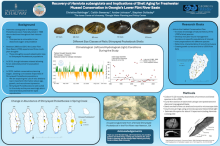Recovery of Hamiota subangulata and Implications of Shell Aging for Freshwater Mussel Conservation in Georgia’s Lower Flint River Basin
Christine
Bahlinger
The Jones Center at Ichauway
Steve Golladay, Georgia Water Planning and Policy Center
Caitlin Sweeney, The Jones Center at Ichauway
Amber Johnson, The Jones Center at Ichauway
Caitlin Sweeney, The Jones Center at Ichauway
Amber Johnson, The Jones Center at Ichauway
Poster
There are at least 25 species of freshwater mussels native to the Lower Flint River Basin (LFRB) in Southwestern Georgia. The Shinyrayed Pocketbook, Hamiota subangulata, was listed as federally endangered in 1998 due to declines throughout their historic range. Between 1999 and 2012, the LFRB experienced three multi-year droughts characterized by extreme low flows during the growing season (May – September). During droughts, extensive segments of once perennial streams dried completely, whereas segments that stayed wet had extended periods of low velocity and isolated pools with hypoxic conditions. Shinyrayed Pocketbooks are highly vulnerable to low dissolved oxygen and predation; populations declined catastrophically during droughts. After a decade of less growing season water scarcity in the basin, surveys of historic mussel sites beginning in 2023 have observed recovery of Shinyrayed Pocketbook populations. Evidence of multiple size classes of individuals has been observed in stream segments where the species was presumed to be extirpated. Other federally listed species in the LFRB tributaries, Medionidus penicillatus and Pleurobema pyriforme, have not shown rapid recovery, likely a reflection of differences in life history strategy among mussel groups. Learning more about the life history of mussel species (e.g., age, recruitment, growth) can be used to inform conservation actions. We are exploring shell aging to determine life spans, characteristics of recruitment years, and perhaps growth rates for both common and rare mussel species in the LFRB. Different mussel species have different strategies for survival, and filling knowledge gaps about their lifespans can help inform management practices and expectations for recovery. The dense network of USGS stream flow stations, extensive climatic information, long term record of mussel sampling, and availability of recently dead shells make the LFRB well suited to this type of study.
Poster PDF

Meeting homepage